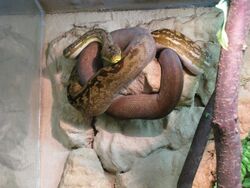Biology:Timor python
| Timor python | |
|---|---|

| |
| Malayopython timoriensis in a zoo | |
| Scientific classification | |
| Domain: | Eukaryota |
| Kingdom: | Animalia |
| Phylum: | Chordata |
| Class: | Reptilia |
| Order: | Squamata |
| Suborder: | Serpentes |
| Family: | Pythonidae |
| Genus: | Malayopython |
| Species: | M. timoriensis
|
| Binomial name | |
| Malayopython timoriensis (W. Peters, 1876)
| |
| Synonyms | |
| |
The Timor python (Malayopython timoriensis) is a python species found in Southeast Asia. A dwarf species, no subspecies are recognized as being valid.[3] Like all pythons, it is a nonvenomous constrictor; unlike larger species such as the reticulated python, it is not considered dangerous to humans.
Description
The Timor python is a fairly long, over 7 ft (2.1 m), but relatively thin python. It has a series of heat-sensing pits between its nostrils and mouth used to find warm-blooded prey in total darkness. It is cold-blooded.[4]
Geographic range
M. timoriensis is found in Southeast Asia on the Lesser Sunda Islands (Flores, Lombien and Timor islands), its type locality is given as "Kupang, (Timor)" [Indonesia].[1]
Behavior
M. timoriensis is partly arboreal.[5]
Feeding
Captive specimens of M. timoriensis have been known to accept birds and small mammals.[4]
Reproduction
M. timoriensis is oviparous.[5]
Taxonomy
Liasis amethystinus var. timoriensis was the scientific name proposed by Wilhelm Peters in 1876.[6]
Authors of a phylogenetic study suggested that the Timor python together with the reticulated python should be moved to a distinct genus Broghammerus.[2] Subsequent phylogenetic analyses have supported the separation of the Timor and reticulated pythons from genus Python. However, Broghammerus is considered an invalid name by most authorities, which made R. Graham Reynolds et al. formally rename this clade Malayopython in 2014, a decision that was followed by many authors.[7][8][9][10]
References
- ↑ 1.0 1.1 McDiarmid RW, Campbell JA, Touré T (1999). Snake Species of the World: A Taxonomic and Geographic Reference, vol. 1. Washington, District of Columbia: Herpetologists' League. 511 pp. ISBN:1-893777-00-6 (series). ISBN:1-893777-01-4 (volume).
- ↑ 2.0 2.1 Rawlings LH, Rabosky DL, Donnellan SC, Hutchinson MN (2008). "Python phylogenetics: inference from morphology and mitochondrial DNA". Biological Journal of the Linnean Society 93: 603-619.
- ↑ "Python timoriensis ". Integrated Taxonomic Information System. https://www.itis.gov/servlet/SingleRpt/SingleRpt?search_topic=TSN&search_value=634786. Retrieved 21 September 2007.
- ↑ 4.0 4.1 Mehrtens JM (1987). Living Snakes of the World in Color. New York: Sterling Publishers. 480 pp. ISBN:0-8069-6460-X.
- ↑ 5.0 5.1 "Malayopython timoriensis ". The Reptile Database. www.reptile-database.org.
- ↑ Peters W (1876). "Über die von S. M. S. Gazelle mitgebrachten Amphibien ". Monatsberichte der Königlich Preussischen Akademie der Wissenschaften zu Berlin 1876: 528–535 + Plate. (Liasis amethystinus var. timoriensis, new variety, p. 533 + Plate, figures 3, 3a, 3b, 3c). (in German).
- ↑ Reynolds RG, Niemiller ML, Revell LJ (2014). "Toward a tree-of-life for the boas and pythons: multilocus species-level phylogeny with unprecedented taxon sampling". Molecular Phylogenetics and Evolution 71: 201–213. doi:10.1016/j.ympev.2013.11.011. PMID 24315866.
- ↑ Kaiser H, Crother BI, Kelly CMR, Luiselli L, O'Shea M, Ota H, Passos P, Schleip W, Wüster W (2013). "Best Practices: In the 21st Century, Taxonomic Decisions in Herpetology are Acceptable Only When Supported by a Body of Evidence and Published via Peer-Review". Herpetological Review 44 (1): 8–23. http://www.markoshea.info/downloads/Kaiser-et-al-2013.pdf.
- ↑ "A review of the systematics and taxonomy of Pythonidae: an ancient serpent lineage". Zoological Journal of the Linnean Society 175: 1–19. 2015. doi:10.1111/zoj.12267. https://academic.oup.com/zoolinnean/article-pdf/175/1/1/16876780/zoj12267.pdf.
- ↑ "The emerging phylogenetic pattern of parthenogenesis in snakes". Biological Journal of the Linnean Society 118 (2): 172–186. 2016. doi:10.1111/bij.12744.
Further reading
- Boulenger GA (1893). Catalogue of the Snakes in the British Museum (Natural History). Volume I. Containing the Families ... Boidæ ... London: Trustees of the British Museum (Natural History). (Taylor and Francis, printers). xiii + 448 pp. + Plates I-XXVIII. ("Python timorensis [sic]", p. 85).
External links
| Wikimedia Commons has media related to Timor python. |
- Malayoython timoriensis at the Reptarium.cz Reptile Database. Accessed 06 January 2021.
Wikidata ☰ Q1815261 entry
 |


